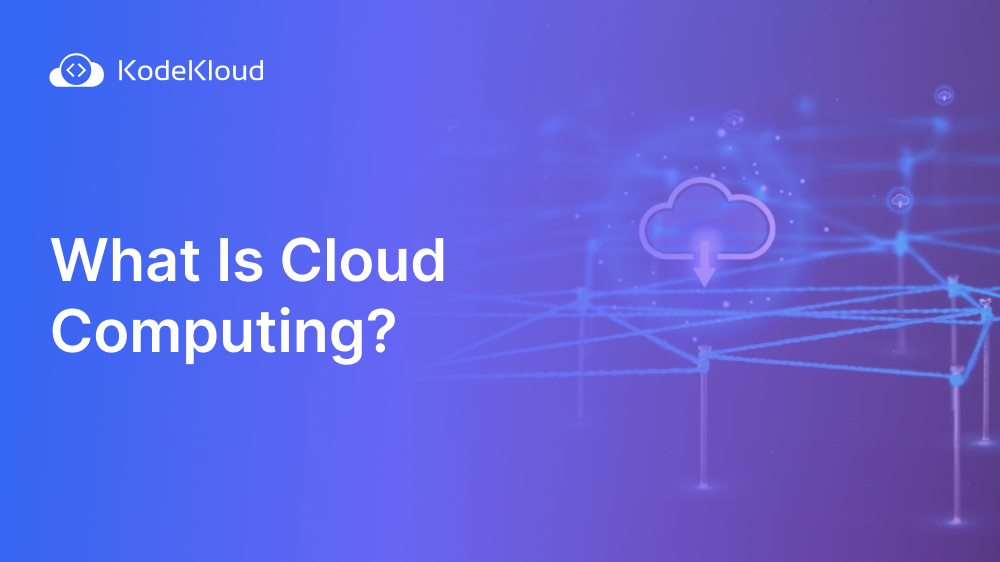Have you ever heard of "the cloud"? You probably have, but maybe you're still unsure what it means. Well, no worries—in this post, we'll explore the world of cloud computing and explain it to you.
First, we’ll understand what cloud computing is. Next, we’ll dive into the different cloud deployment models. Finally, we’ll understand the benefits and drawbacks of cloud computing. Let’s get started!
What is Cloud Computing?
Cloud computing refers to the delivery of computing services, including servers, storage, databases, networking, software, and more, over the Internet. Instead of owning and maintaining physical data centers and servers, individuals, and organizations can access technology resources from a cloud service provider as needed.
The term "cloud" in "cloud computing" refers to the delivery of computing services over the internet. The term "cloud" is used to describe this delivery model because the services are not provided from a single, specific physical location, but rather from a network of remote servers that are accessible over the internet.
Cloud Computing Services & Resources
So, what kind of services and resources can you get from the cloud? The list is pretty much endless, but some common ones include:
- Compute: This refers to the processing power of remote servers, which users can access to run applications and perform computationally intensive tasks.
- Storage: This refers to the remote storage of data, allowing users to store and retrieve their data.
- Networking: This refers to virtualized network infrastructure, including load balancing, security, and other network-related services.
The beauty of cloud computing is that it offers all these services and resources in a flexible, scalable, and cost-effective way. By accessing everything over the internet, you can get exactly what you need when you need it and only pay for what you use.
Cloud providers offer cloud computing services. Amazon Web Services (AWS), Microsoft Azure, and Google Cloud Platform (GCP) are the three dominant cloud providers.
Now that we understand cloud computing let's explore the available deployment models.
Cloud Deployment Models
A cloud deployment model refers to the manner in which cloud computing services and resources are made available to users. It determines who has access to the cloud and the level of control and security available to them.
There are three main cloud deployment models: public, private, and hybrid.
Public Cloud
A public cloud allows anyone with an internet connection to access a shared pool of computing resources. Third-party service providers own and operate public clouds, making them accessible to the general public. Examples of public cloud providers include Amazon Web Services (AWS), Microsoft Azure, and Google Cloud Platform (GCP).
Private Cloud
Private clouds are designed for the exclusive use of a single organization. These clouds are typically hosted on the organization's own infrastructure, such as its own data centers, or by a third-party provider on behalf of the organization. Private clouds provide a high degree of control and security. They are ideal for organizations handling sensitive data.
Hybrid Cloud
Hybrid clouds are a combination of public and private clouds. For instance, an organization can utilize the public cloud for non-sensitive workloads and the private cloud for sensitive workloads. Organizations have access to the scalability and cost savings of public clouds while still maintaining control and security over their most critical data and applications.
Next, let’s explore the advantages and disadvantages of cloud computing.
Advantages of Cloud Computing
Below are the advantages of cloud computing:
- No initial cost: There are no capital costs, and operating costs are more optimized; payment is only made for the resources used. Companies can easily scale their resources up or down based on changing needs without investing in additional hardware or infrastructure.
- Flexibility: Users can access cloud services from anywhere with an internet connection, providing flexibility for remote work and collaboration.
- Scalability: Cloud computing allows businesses to easily scale their resources up or down based on demand, ensuring they always have the necessary computing power.
- Fast implementation: A completely ready-to-use service is provided within one working day. You can also spin up servers, databases, and other instances in just a few minutes.
- High availability: Cloud services are designed to be highly available and reliable, with built-in redundancy and failover capabilities.
- Data safety: The ability to recover data of any period in case of their deletion in the office.
- Security: Cloud providers often have robust security measures to protect data, which can be more comprehensive than what many businesses can implement on their own.
Automatic failover automatically transfers operations to a secondary, functioning server in the event of a failure of the primary server. Load balancing makes sure that traffic is spread evenly across multiple servers so you don't see any downtime.
Disadvantages of Cloud Computing
While cloud computing offers many benefits, it also has a few drawbacks:
- Security concerns: Storing data in the cloud may raise security and privacy issues, as it can be vulnerable to hacking and unauthorized access.
- Downtime: Reliance on a third-party service for computing and storage means that downtime or outages on the provider's end can disrupt operations.
- Dependence on Internet connectivity: Cloud computing requires a stable Internet connection, so if there are connectivity issues, access to data and applications may be affected.
- Data transfer costs: Transferring large amounts of data to and from the cloud can incur additional costs, especially if the data needs to be accessed frequently.
- Limited control and customization: Users may have limited control over the infrastructure and may be unable to customize the environment to their exact specifications.
- Compliance and legal issues: Depending on the location of the cloud provider's data centers, compliance and legal issues may be related to data sovereignty and jurisdiction.
Cloud providers often use dynamic pricing models that can change based on usage or other factors. This can lead to unexpected costs. So it's important to closely monitor your spending and understand how the pricing works.
To get started with the cloud, check out our Cloud Learning Path:

The Cloud Learning Path offers a comprehensive journey for individuals seeking proficiency in cloud computing across various platforms.
Conclusion
I hope this post has helped you understand cloud computing. By now, you should have a good grasp of its advantages and disadvantages, as well as various cloud deployment models.
Whether you're just starting your tech career or looking to expand your skill set, learning about cloud computing could be a wise investment in your future.
Other interesting reads:
- Top 10 Cloud Computing Skills You Need in 2024
- What is Cloud Data Security? Risks and Best Practices
- How to Prevent Cloud Computing Attacks
- Cloud Computing And DevOps: What You Need to Know
- How To Learn Cloud Computing
- Git vs. GitHub vs. GitLab
- Demystifying Container Orchestration: How Kubernetes Works with Docker
- Deploying, Maintaining, and Scaling Kubernetes Clusters



















Discussion